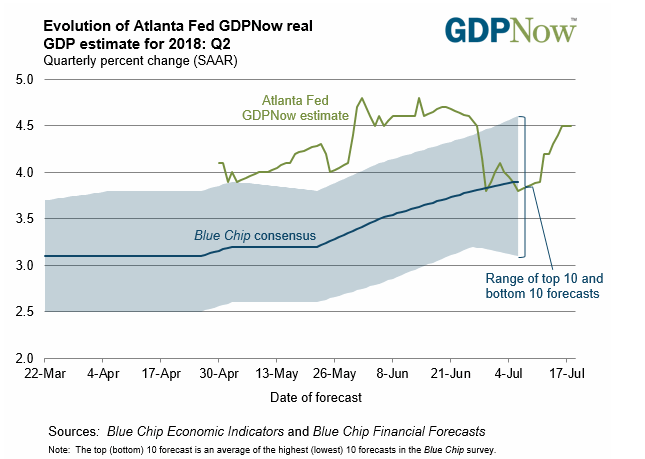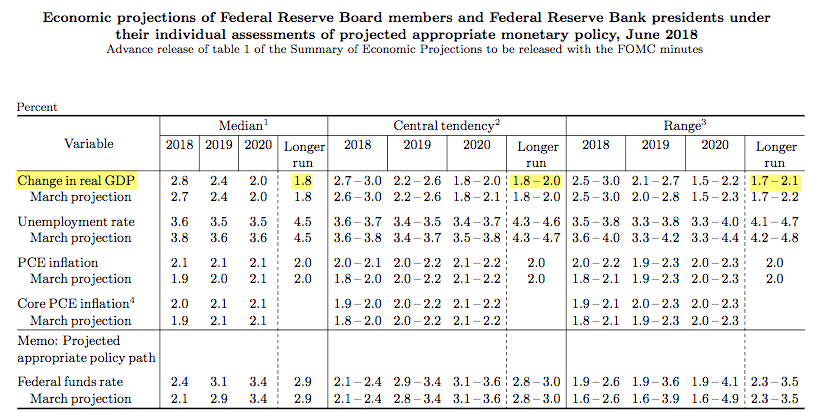Some brief housekeeping issues. I am switching it up here with a daily. I used to do these potpourri posts more often before Boom Bust. And so, now that I am starting up Credit Writedowns Pro again, let’s resume doing them. Expect these posts to come earlier in the morning and to evolve over time as I figure out the format and workflow.
Here goes.
P.S. – Patreon Subscribers, remember you can find registration info for Credit Writedowns here. Also, I recently downloaded the Patreon Android app and really like it. It’s great for the subway as it caches posts and also gives you post alerts.
1 big thing: The US economy is booming

Source: Atlanta Fed
I told you Monday that the Atlanta Fed’s latest GDPNow figure for Q2 growth was 4.5%. They’ve updated those figures and the numbers still come in at 4.5%, well above my 3.0% bogey for a robust quarterly showing.
Why does this matter?
- First, any worries about near-term recession — or even slowing — are misplaced. We are now solidly into a 3% growth phase in year-over-year numbers
- 3% growth is well ahead of the Fed’s conceptual 2% potential GDP estimates. And so the Fed will continue to gradually raise rates as long as these numbers are in the 3% range

Source: Federal Reserve
Corollary: Policy divergence is back on in a big way. Elsewhere in the global economy, there is less boom. That’s certainly true for Europe and China, America’s ‘foes’ in the recent trade war. So expect an impact on the spread between US short rates and short rates elsewhere, as well as on currency values.
Contrarian point: As the Fed raises interest rates, most people expect this to tighten. And it will eventually tighten financial conditions with a lag. But before the lag, we will see acceleration via increased interest income and borrowers pulling forward credit demand in anticipation of more tightening. GDP growth numbers may continue to remain elevated, causing the Fed to overtighten.
2. Jerome Powell’s Congressional testimony sounded hawkish
On Tuesday, the Fed Chairman gave his Semiannual Monetary Policy Report to the Congress. And his comments showed great optimism about the US economy’s resilience.
Why does this matter?
If anything, his comments on the state of the economy appeared hawkish. Everything he said was positive, with a tinge of worry regarding overheating. Look at the bolded parts below.
- “Since I last testified here in February, the job market has continued to strengthen and inflation has moved up.”
- “An average of 215,000 net new jobs were created each month in the first half of this year. That number is somewhat higher than the monthly average for 2017. It is also a good deal higher than the average number of people who enter the work force each month on net.”
- “Another piece of good news is that the robust conditions in the labor market are being felt by many different groups. For example, the unemployment rates for African Americans and Hispanics have fallen sharply over the past few years and are now near their lowest levels since the Bureau of Labor Statistics began reporting data for these groups in 1972. Groups with higher unemployment rates have tended to benefit the most as the job market has strengthened.“
- “Core inflation excludes energy and food prices and generally is a better indicator of future overall inflation. Core inflation was 2.0 percent for the 12 months ending in May, compared with 1.5 percent a year ago. We will continue to keep a close eye on inflation with the goal of keeping it near 2 percent.”
Between the lines: Forget the boilerplate about the risks being roughly balanced. Look at Powell’s actual comments on the economy. They all show confidence in economic growth and a mild fear of overheating.
Contrarian take: The Fed could continue to accelerate its rate hike timetable under Powell. 2018 is now roughly balanced for three or four rate hikes. Expect the balance to tip decidedly toward four in the September projections if the economy stays on track.
3. Emerging markets are still under stress
Some investors are plowing cash back into local-currency emerging-markets bonds after a 40% plunge in EM currencies since 2011’s peak. https://t.co/haKJcEazLS pic.twitter.com/Y5BOBRBEv3
— Lisa Abramowicz (@lisaabramowicz1) July 17, 2018
That was yesterday but today:
As the dollar strengthens further, emerging-markets currencies are falling today the most for a single day since May 2017, to a new one-year low. pic.twitter.com/OzF0cD88Ar
— Lisa Abramowicz (@lisaabramowicz1) July 19, 2018
Deeper analysis: Even the Indian Rupee is getting killed here. The Indian economy grew by the most of all major economies in 2017, faster than China. Yet, its currency is hitting record lows. This speaks to building distress on EM markets.
Why it matters: We all know Turkey is in trouble. But Turkey is not necessarily an outlier here.
Among the key takeaways: As long as the US economy continues to chug along, the Fed will remain in a tightening bias mode. And that means policy divergence, where US short rates move higher as other economies’ short rates stall.
Contrarian questions: As EM currencies decline, exports to the US by emerging market countries could increase. That would help these countries build their foreign exchange reserves. Another take is that these currency moves are actually the result of US dollar buying to build reserves rather than a strong US economy putting upward pressure on the dollar. Watch this question in the coming weeks as it is important regarding the stress on EM economies.
4. US Auto manufacturers are negative on import tariffs
The auto industry is unified in its opposition to the Trump administration’s proposal to impose tariffs as high as 25 percent on imported cars, but leaders fear the message is likely not to be heeded.
Groups that lobby for both Detroit manufacturers and their foreign counterparts will testify at a public comment hearing organized by the U.S. Commerce Department on Thursday, which is considering the duties under the guise of national security. The agency received 2,356 written comments — mostly negative — that included submissions from General Motors Co. and Toyota Motor Co.
You would think that US carmakers would be happy that they see less competition from abroad. Apparently they are not. Their fear is that “tariffs on autos and auto parts would be a massive tax on consumers ” and that the higher costs those consumers face would lead to declining sales for all cars.
Why it matters: this is the first big test for Trump on trade. He has touted these tariffs as helping protect American jobs. Yet the companies who employ the people whose jobs he is looking to protect are coming out against his preferred policy remedy. Will Trump change course?
Deeper analysis: The unintended consequences of protectionist policy on US companies are manifold.
If the U.S., for any reason, cuts its imports from a trading partner, that country’s economy and currency both weaken, so it buys less from U.S. companies.
Even Whirlpool, which benefitted from washing machine tariffs, is now worried about the steel and aluminum tariffs adding to costs.
Takeaway: With the economy booming, the Republicans have a tailwind on that front. Anything that muddies the water on the economic success Republican rule in Washington has delivered will be negative for Republicans in the mid-term elections in November.
5. MMT and the coming debate on budgetary constraints
I think monetary and fiscal space will be very limited in the next US downturn. And on the fiscal side, that’s not because of hard constraints. It’s because of political constraints. The FT outlines the issues:
Modern Monetarists argue that the debt to GDP ratio is irrelevant. When a government borrows, they say, it is simply creating money. Financiers know this to be true, because an institutional investor who says she’s “going to cash” is not, in fact, buying piles of printed bills. She’s buying government debt, most likely from the US, Germany, Japan or Switzerland.
Wall Street sees government debt as an asset to hold — a money equivalent. And so the modern monetarist answer to “how much debt” is: it depends on how many people are willing to treat that debt as money.
[…]
On at least an instinctive level, American politicians have always known this….
Why this matters: Trump is the result of large-scale unease in the status quo in Washington. If he fails, American voters may not go back to the status quo. Instead they could shift allegiance en masse to politicians like Alexandria Ocasio-Cortez whose policies are the polar opposite of Trump’s in many respects.
Deeper analysis: When the next recession hits, the issue of self-imposed constraints will become important regarding macro responses. Many in the US electorate still feel that the policy remedies from the crisis that began in 2007 were unfair. They say Wall Street got bailouts while people lost their homes and jobs. So even though the US economy is booming, underneath there is still a deep-seated feeling of anger about equity in how government largesse is distributed. A recession will bring that anger out in droves.
That’s it. My first daily newsletter is out. Comments are appreciated. If you’re reading this on Credit Writedowns Pro and are not subscribed yet, hit up the link here and help support this site.
Cheers,
Edward
Comments are closed.